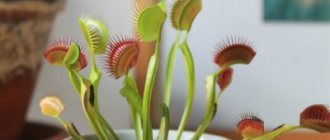Author: Elena N. https://floristics.info/ru/index.php?option=com_contact&view=contact&id=19 Category: Houseplants Published: February 04, 2019Last edits: January 11, 2021
- Growing from seeds
- Pests and their control
- Cyperus alternifolius
The cyperus plant (lat. Cyperus), or syperus, or sulphur, is a numerous (about 600 species) genus of herbaceous perennials of the sedge family, naturally growing in tropical and subtropical regions of the Earth on the banks of rivers and reservoirs, but most often cyperus flowers are found in Africa. In our country, such relatives of cyperus are known as sedge, reed and sytnyag. The cyperus flower is to some extent similar to a dill umbrella or a small grassy palm. It cannot be said that this representative of sedges is so attractive, but if it grows in a dense island on the shore of a pond, it looks impressive. In ancient times, one of the now endangered species of this genus was used to produce writing material - papyrus, which is why it is called “cyperus papyrus”. Cyperus is not of great interest to branded flower shops, but in the grandmothers' market, "cyperus palm" is the same popular product as Saintpaulia.
Planting and caring for tsiperus
- Flowering: grown as an ornamental foliage plant.
- Lighting: bright diffused light, partial shade (eastern or western window sill).
- Temperature: in summer – normal for residential premises, in winter – not lower than 12 ˚C.
- Watering: frequent and plentiful.
- Humidity: very high. It is recommended to constantly spray the leaves and keep the plant on a tray with wet pebbles.
- Feeding: complex fertilizer for decorative deciduous plants: in the warm season - twice a month, in winter - once.
- Rest period: not observed.
- Replanting: as needed at any time of the year.
- Reproduction: by seeds, dividing the bush, apical cuttings and rosettes.
- Pests: spider mites, aphids.
- Diseases: does not get sick, but due to insufficient humidity it may turn yellow and lose its decorative effect.
Read more about growing Cyperus below.
Botanical description
Cyperus in natural conditions grows up to three meters in height. Its stems are erect, triangular, at their top there are umbrella-shaped whorls of long leaves of different shades of green, although there are variegated varieties in cultivation. Small flowers are unattractive; they hide in the axils of the leaves. Homemade cyperus is an unpretentious, shade-tolerant plant; it is grown to decorate shaded areas of the room or small artificial reservoirs.
Habitat
The island of Madagascar and the tropical forests of Africa are considered the homeland of Cyperus. For its love of ponds and constantly moist soil, in Egyptian folklore the flower was called “gift of the river.” This plant is found both in America and in Eurasia along the banks of rivers, lakes and swamps in close proximity to water and in water, where it forms impenetrable thickets. Cyperus was brought to Europe in the 18th century, and it began to be grown indoors in the 80s of the last century. Sitovnik quickly gained popularity due to its unique elegant appearance (looks like a dill umbrella or a small grassy palm) and ease of care.
In our country, such relatives of Cyperus are known as Kamysh, Sedge and Sitnyag.
Caring for Cyperus at home
Growing conditions
Even a novice gardener can grow a houseplant called Cyperus. Cyperus care consists of properly organized watering and timely balanced feeding of the plant. But first, let's determine where it is best to place the plant.
Despite its shade tolerance, the indoor cyperus flower, like its wild relatives, loves bright, diffused light and can even withstand direct sunlight for some time, so if you don’t have any special plans for the cyperus, place it on a western or eastern windowsill. Or in the south, but then in the summer you will have to shade it from the scorching midday sun.
- How to make a violet bloom for a long time - 3 conditions for long and abundant flowering of Saintpaulia
In summer, indoor cyperus normally withstands the usual temperature for a home at this time, but it needs a constant supply of fresh air, and even better - summer holidays in nature. In winter, Cyperus prefers coolness, but the temperature in the room where Cyperus is located should not be lower than 12 ºC.
The plant loves moisture very much, and it is not for nothing that some gardeners grow Cyperus in an aquarium. At home, it is better to keep the excessively moisture-loving cyperus on a tray with wet pebbles (expanded clay) or in a flowerpot with water, sprinkling the soil in the pot with the plant with a layer of sand. Watering is needed abundantly and frequently so that the soil in the pot is always moist. Reduce watering only in winter, when the cyperus is transferred to a cool room.
Cyperus leaves need high air humidity, so do not forget to spray and wash them with settled water. In winter, spraying can be stopped, but keep Cyperus away from heating appliances.
Fertilizer
Cyperus does not have a rest period; it grows all year round, so it needs feeding all the time. In the spring and summer, cyperus is fed once every two weeks with complex fertilizer for decorative foliage plants. In winter, one feeding per month is enough.
Transfer
How to plant cyperus or transplant it into a new pot? Since the flowering of Cyperus is not of interest, and it does not need rest, it can be replanted at any time, but it is better to do this in March, provided that the roots are already really cramped in the pot. The most suitable soil for Cyperus is a slightly acidic, nutritious soil consisting of humus and peat soil in equal parts, preferably with the addition of a small amount of swamp silt. A pot for cyperus needs a tall pot, one-quarter filled with drainage material.
Cyperus is planted by transferring the root ball into a new pot along with the soil adhering to it, then you need to gradually add soil until the pot is full.
- Reo at home: planting and care
Transfer
Young plants are replanted annually, adult specimens - once every 2-3 years and as needed.
Cyperus is an unpretentious plant, so it
can be replanted at any time of the year.
Despite the fact that the rush plant is moisture-loving, it is still worth adding drainage to the bottom of the pot.
Expanded clay should occupy ¼ of the growing container.
Since Cyperus has a shallow root system, the container should be wide, but not deep.
You need to replant in a nutritious soil mixture with a neutral reaction.
Methods for preparing soil at home
- You need to take 1 part of high-moor peat, one part of humus and 1/6 of swamp silt.
- Mix one part of leaf soil with one part of river sand, one part of peat and two parts of clay-turf soil.
When preparing the substrate, it is recommended to add charcoal and crushed eggshells. Cyperus can be grown hydroponically.
Reproduction of Cyperus
If you are interested in how to grow cyperus at home, you should know that it is propagated by seeds, leaf rosettes, apical cuttings and dividing the bush, and propagation of cyperus papyrus occurs only by dividing the bush and by seed.
Growing from seeds
So, how to propagate cyperus from seeds? Growing Cyperus from seeds requires long daylight hours, so it is best to sow Cyperus when the nights become short. Sowing of seeds is carried out in bowls with a mixture of peat and leaf soil, one part of each and half a part of sand. It is better not to plant the cyperus seeds, but to press them tightly to the ground, and then cover the bowls with glass. The temperature for successful germination should be 18 ºC, the water for daily moistening of the soil should be warm. Be sure to ventilate the crops and remove condensation from the glass.
When the seedlings appear and grow stronger, they are planted in pots with a diameter of 9 cm, three seedlings in one, with the optimal soil composition: one part of turf and peat soil and half of sand. As soon as Cyperus from seeds takes root, care for it as you would an adult plant. Let me remind you that during seed propagation, the varietal properties of Cyperus (for example, variegation of leaves) may not be preserved.
Vegetative methods of propagation
Dividing a cyperus bush: when replanting a plant older than two years, divide the bush into several parts and plant them in different pots. Cyperus recovers very quickly.
Propagation of Cyperus by rosettes: the leaf rosette is cut off with a part of the stem about 5 cm long and planted in the sand, providing bottom heating to 20-24 ºC. Or they tilt the stem, lowering the leaf rosette into a container of water, and fix the cuttings in this position until the roots grow; then the rosette is cut off and planted in the ground.
Propagation of Cyperus by apical cuttings: cuttings are cut in the spring, the leaves on them are shortened by two-thirds and the cuttings are placed in water to grow roots. When the roots appear, the cuttings are planted in pots with a diameter of 7 cm.
Pests and diseases
Pests and their control
Cyperus is a plant resistant to both diseases and pests, but if you are careless in its care, it can be affected by aphids and spider mites. It is easier to prevent trouble than to spend weeks getting rid of it, so do not forget to monitor the condition of the soil of the cyperus and maintain air humidity at the required level.
- How gerbera blooms at home
Cyperus is drying up
When the tips of the leaves of Cyperus dry out, this is a signal that the plant is suffering from dry air, and before the plant dies, take immediate action: spray the leaves with settled water, place the pot of Cyperus in a pot with water or on a tray with wet expanded clay, and most importantly, keep it away from working radiators.
Cyperus turns yellow
This usually occurs due to dryness in the roots. You are not watering your cyperus enough. Correct your mistake and do not repeat it in the future, because the color lost by the leaves is not restored, and the yellow leaves need to be cut off with the stems right at the root.
Bloom
Cyperus is a flowering plant. Peduncles are triangular in shape. They are erect, but flexible, so they do not break under the pressure of the wind. Small, inconspicuous flowers of Cyperus are arranged singly or in a rosette. They are pale green, light brown or milky in color. Most often, flowering is observed in the summer, in June or July, but some varieties bloom throughout the summer until mid-autumn. After flowering, small fruits appear - nuts or spikelets of a brownish color. Pollination occurs due to wind - fine pollen is quickly carried by the wind to nearby plants.
Kinds
Cyperus alternifolius
The most common in culture can be considered the cyperus alternifolius (Cyperus alternifolius), which grows up to one and a half meters in height, although there is a variety of gracilis only 35-50 cm tall. This species has tall graceful stems, like a reed, at the top of which is a whorl of narrow, pointed, curved leaves. There is also a pinnate form of Cyperus umbellata with white stripes on the leaves - variegatus.
Cyperus papyrus
A herbaceous perennial up to three meters tall, growing abundantly in the swamps of Ethiopia and Egypt. The stems are straight, triangular in the upper part, with rosettes of hanging leaves located at the tops of the stems. Multi-flowered inflorescences emerge from their axils.
Cyperus diffusus
It grows up to 90 cm in height, the stems are few in number, but there are many long and wide basal leaves. At the top of the shoots, leaves are up to 30 cm long and up to one and a half cm wide.











